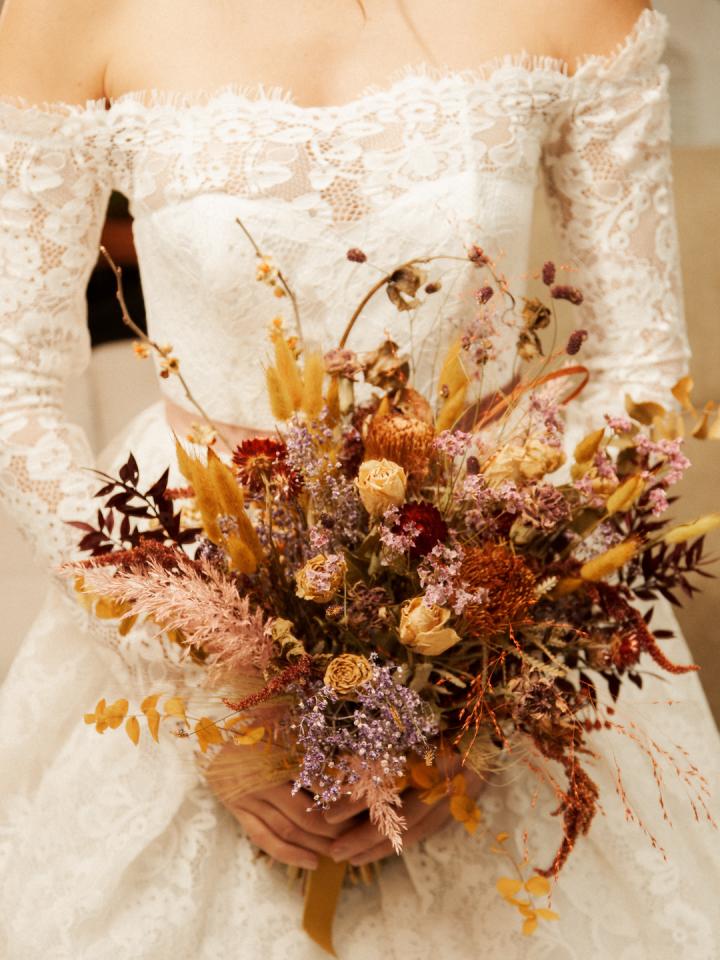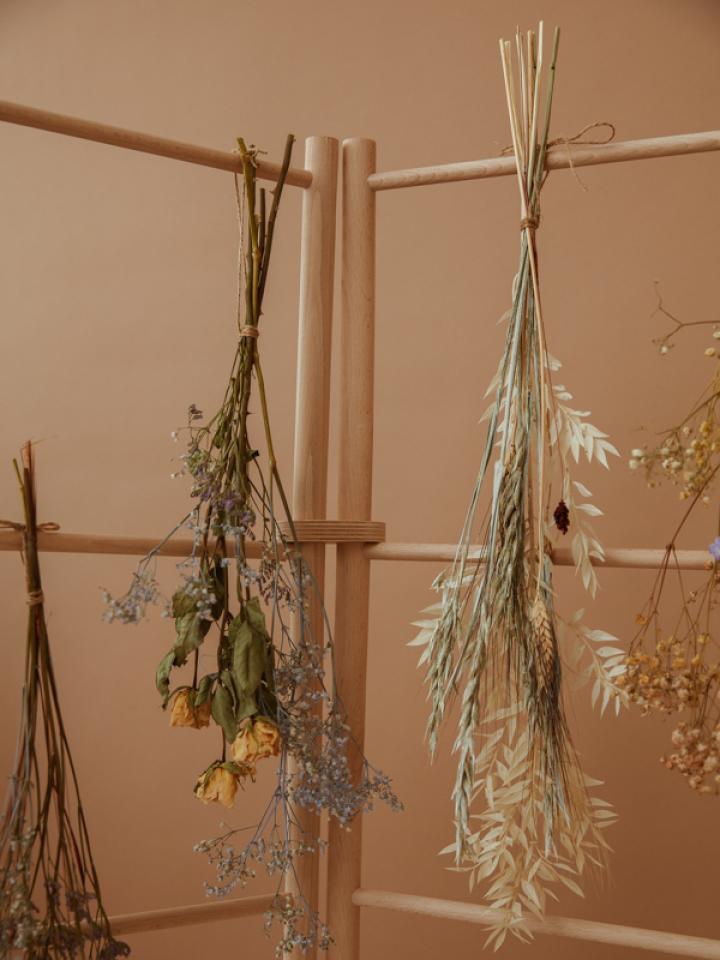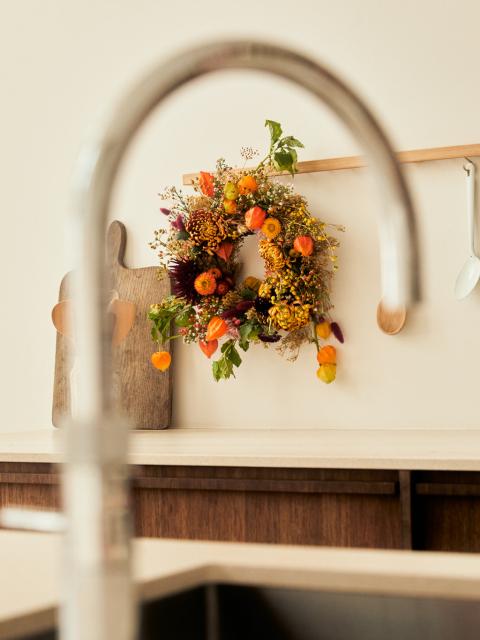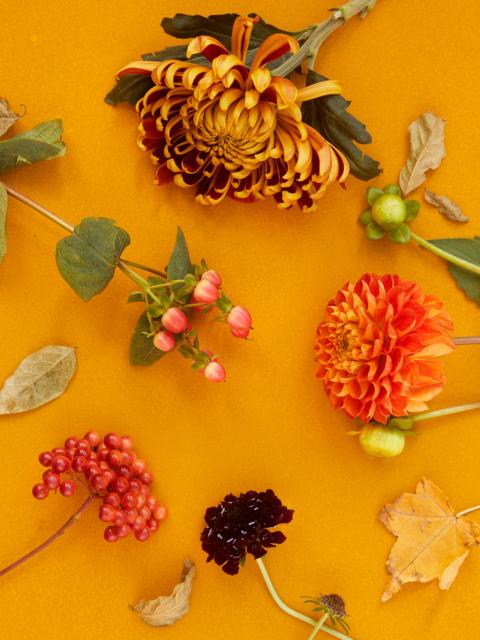Buy pre-dried flowers or do it yourself
There are two ways to create a dried flower arrangement. The first is to purchase pre-dried stems from the florist and arrange them at home. Ask for a mix of sculptural elements in different tones, to create a display that is eye-catching and enchanting. The second option is to buy a bouquet of fresh cut flowers and dry them yourself at home, which is both creative and rewarding.
five WAYS to dry flowers yourself
There are different ways to dry flowers depending your preferences and desired result. Do you want the flowers to be flattened or to keep their shape? If you dry flowers between a book or a press, you will flatten them and they will be suitable for framing. If you air-dry your flowers, in the oven or in a cardboard box, they will keep their shape and be better suited for a vase.
1) AIR-DRYing FLOWERS
Arrange small bunches of the same flowers, tie them with string or elastic and hang the flowers upside down to dry. For best results, do this in a dark and warm place, such as in the loft (possibly close to the heating or boiler for extra warmth) or in an airing cupboard. The warmth speeds up the drying process and prevents the flowers from going mouldy. The darker the spot, the better the flowers keep their colour. After a few weeks the flowers will have dried. You can test this by squeezing the stem. If it's no longer flexible, your dried flowers are ready to shine! Would you rather dry the flowers outside? You can do that too!
2) DRYING FLOWERS in the oven
Want to try a different drying technique? Set a convection oven to 40°C and tuck the flowers between or into an oven rack so that they stand upright. After 3-4 hours, remove the dried flowers and let them cool completely on another rack. When the petals have turned crisp, the flowers are dry enough. Chrysanthemums are especially suitable for drying in this way.
3) DRYING FLOWERS BETWEEN the pages of a BOOK
Spread your favourite flowers between paper that absorbs moisture, such as tissue paper, and then place the paper between the pages of a heavy book. Make sure the layer of pages between the flowers is at least 0.5 centimetres. Don't overstuff the book and ensure even pressure distribution for the best results. It takes about three weeks to dry flowers in this way. Make sure you change the tissue paper regularly so that the flowers do not rot when moisture is released. Open the book only after two weeks to check for mould and replace the paper. If you do this earlier it may affect the colour of the flower and there is a chance that flowers will shift and not press properly.
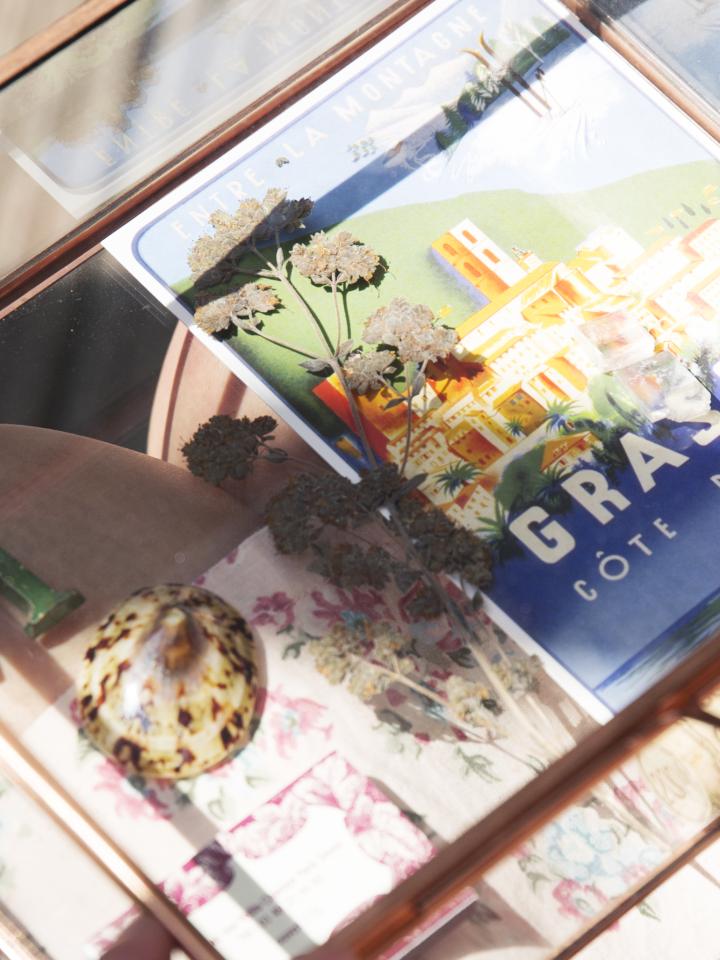
4) DRYING FLOWERS IN A FLOWER PRESS
Carefully place your flowers or petals between pieces of tissue paper and cardboard in a press. Keep this order: cardboard, paper, flower, paper, cardboard, etc. You can make several layers. Flowers come out of the press as you put them in, either open or closed. You can experiment with this to see what gives the best results. Keep turning the press so the flowers become flatter than they do between the pages of a book. It's worth knowing that using a press can cause the flowers to discolour because of their natural dyes. White flowers usually turn yellow, red tulips turn dark red and poppies can turn purple. Flowers with bright colours (such as pink and yellow) usually retain their colour.
Note: not all flowers are suitable for pressing. They shouldn't be too thick, moist or too fragile. Fresh flowers with a thin, sturdy stem, such as delphinium, daisies, Christmas rose, herbs and Zeeland knot, are great for drying. Thick flowers that contain more moisture, such as sunflower and rose, are less suitable for pressing. We suggest pressing individual rose petals rather than the entire bloom, for example.
5) DRYING FLOWERS IN A CARDBOARD BOX
Flowers also dry beautifully in a cardboard box with a lid. You don't need to press the flowers, but can simply place them, whole, into the box. Unlike drying flowers between a book or drying flowers between a press, the flowers are not flattened, making them suitable to display in a vase. Note: drying them in a cardboard box (rather than upside down in the air) does cause the stems to warp.
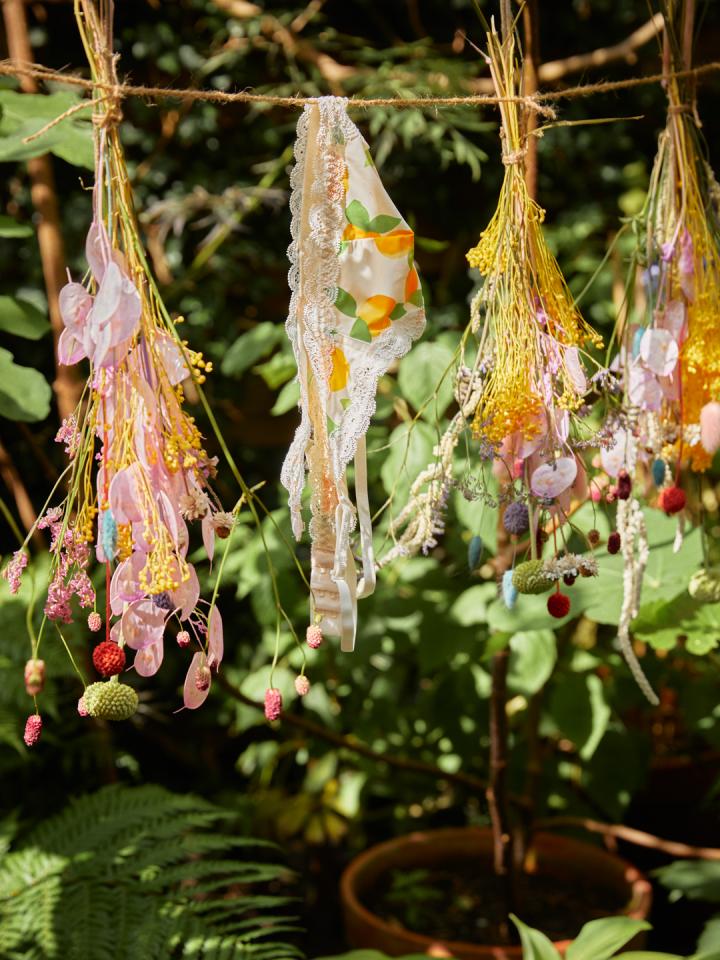
HOW TO DRY FLOWERS ON YOUR CLOTHESLINE
Did you know you can dry flowers on your clothesline outside in warm weather? Arrange small bunches of the same flowers and hang them upside down on the clothesline to dry. For best results, hang them from a spot in the shade. After a few warm, dry days, the flowers will have dried. Test if the flowers are dry by squeezing the stem - if it's no longer flexible, your flowers are ready to use.
TIPS FOR DRYING FLOWERS
- Before you start drying flowers, it's useful to know which flowers dry well and which don't. Choose flowers with woody stems (such as rose and sunflower) or thin stems (such as gypsophila, waxflower).
- You'll achieve the best results with fresh cut flowers at their height of bloom. Make sure to dry them off well before starting to dry them.
- The quicker the flowers dry, the better they keep their original shape and colour.
- Flowers in bright colours such as purple, blue, orange and pink are dry the most successfully because they retain their colours best.
- Make sure to remove any bugs or insects from the flowers before drying them.
- Cut any flower pistils away, as they often don't dry well.
- Have your flowers dried? Spray some hairspray on the dried flowers. This makes them less fragile, which makes the flowers less likely to fall apart.
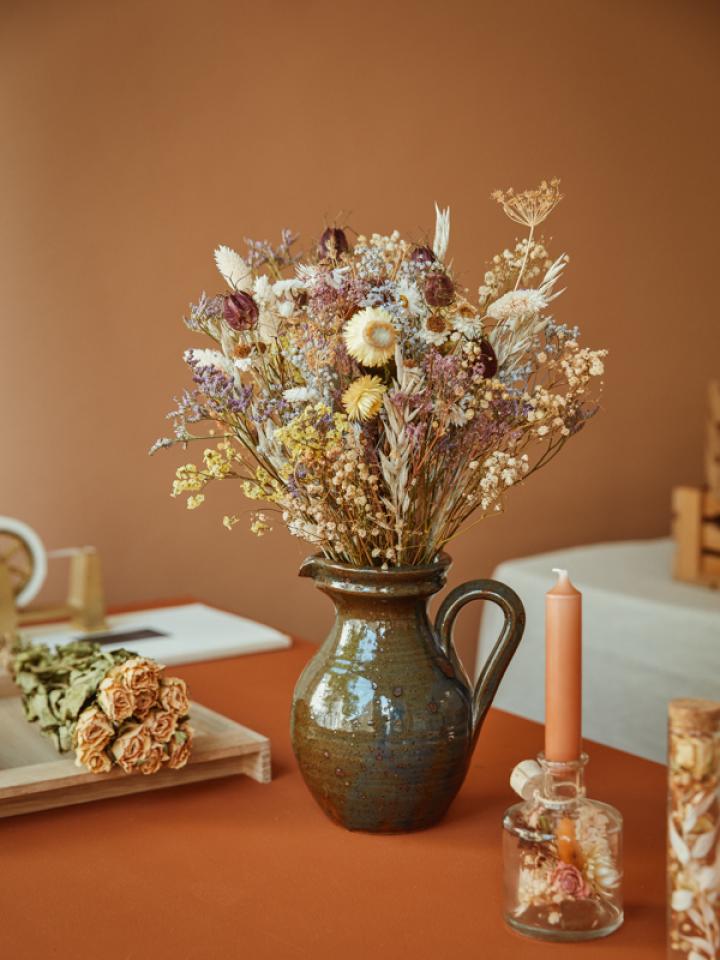
HOW LONG DOES IT TAKE FLOWERS TO DRY?
The drying time of flowers can vary between two weeks and two months. Most flowers are dry after two-four weeks. You can check whether a flower is dry enough by feeling the stem and flower. Is the stem no longer flexible and does the flower feel crisp and brittle? Then your dried flower is ready to shine! The exact drying time of flowers differs from flower to flower and depends on the following factors:
- The method you use. The more efficiently you work, the faster the flower will dry.
- Thickness of the stem: the thicker the stem, the longer it takes for the flower to dry.
- Thickness of the flower: the thicker the flower, the more moisture it contains and the longer it takes for the flower to dry.
- Conditions of the flower before you dried it: was the flower still damp or not? The more moist the flower, the longer it takes for the flower to dry.
How do you store dried flowers?
If you're not planning on using your freshly dried flowers immediately, it's important to keep them well. Store dried flowers flat, in a dark, dry place at room temperature. This will prevent flowers from discolouring or becoming damp. A cardboard box is very suitable for storing dried flowers, but do not use a plastic box because plastic doesn't breathe, which can cause the flowers to go mouldy.
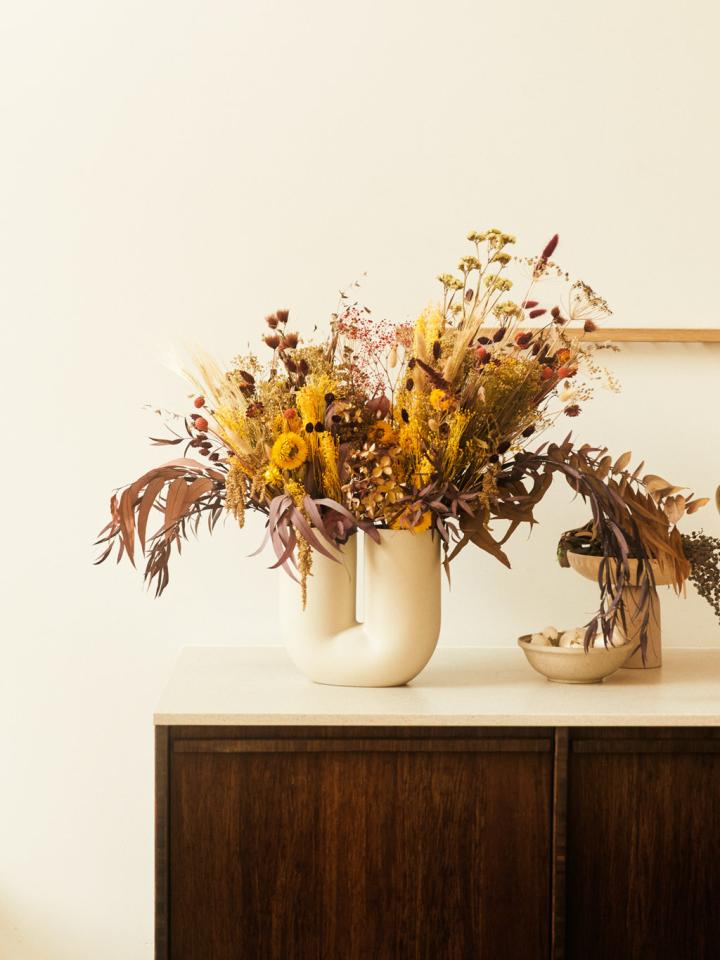
HOW TO USE DRIED FLOWERS
Once your flowers are dried, the possibilities for decoration are endless. Check out our DIY ideas below for inspiration.
- Dried flowers in a vase: one of the most common ways to decorate dried flowers is in a vase as a dried bouquet. How about this grand dried bouquet in warm colours?
- Framing dried flowers: in a picture frame on the wall, above your bed or on the sideboard. A bouquet received for a special moment such as a wedding or anniversary is particularly suited to display in this way.
- Flower cloud: for an original and dreamy DIY, make a flower cloud with dried flowers! Flower stylist Yoko Negi explains how.
- Wreath of dried flowers: create a wreath of dried flowers for Easter or another seasonal event.
- Bridal bouquet of dried flowers: a gorgeous dried bouquet that's perfect for an autumn wedding.
- Make tea with dried flowers: did you know that you can make delicious tea from certain flowers, such as chamomile and chrysanthemum?*
*Please note: never sink your teeth into any cut flower or plant. Only use flowers that are suitable for consumption.
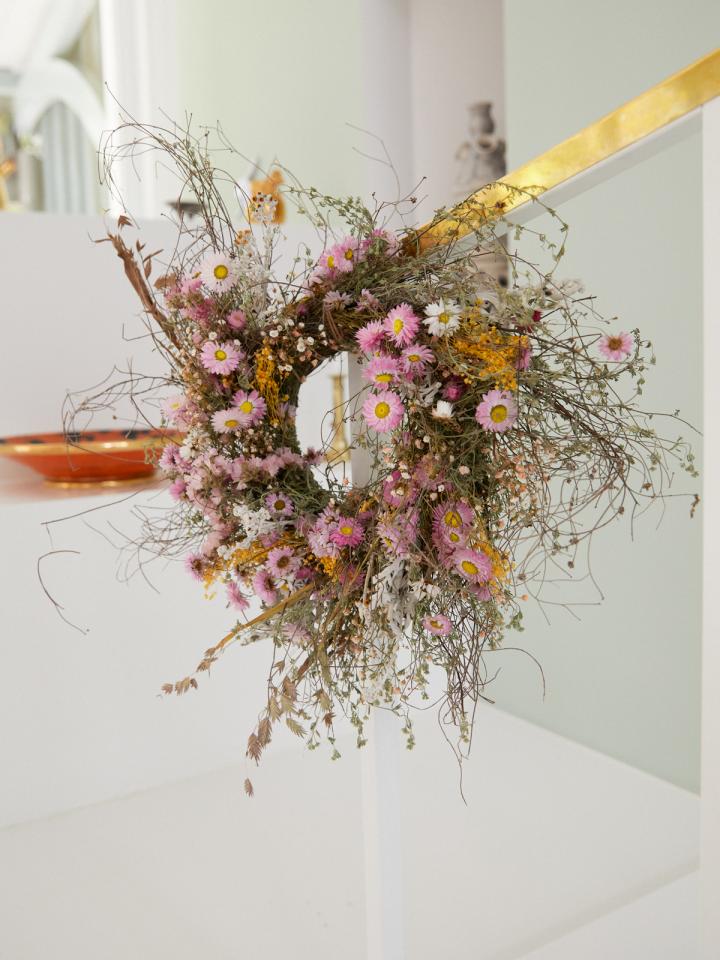
WHICH FLOWERS CAN YOU DRY?
Many flowers are suitable for drying, but in general, flowers with a moist or thick stem are less ideal (such as amaryllis, daffodils and tulips). Flowers with a firm, woody stem lend themselves best to drying, such as the below:
- Gypsophila
- Rose
- Peony
- Poppy
- Hydrangea
- Lavender
- Limonium (sea lavender)
- Grasses
- Sunflower
- Cornflower
- Blue thistle
- Cow parsley
- Helipterum
- Helichrysum (Strawberry)
- Common knotweed
- Craspedia
- Eucalyptus
- Willowherb
- Yarrow
- Angelica
- Physalis
